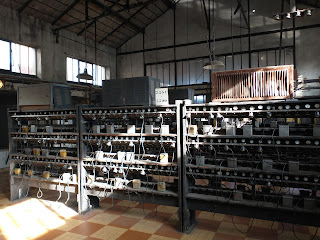Sunday, 01 October 2023
Another early morning. Short walk to the Metro station, then a short ride to the Lille train station. When they announced the platform for my train, I saw that there were two trains on the same platform at the same time. Oh no, you're not gonna fool me again.
When I got to the platform and looked at the monitor that shows which section of the platform to use for which car of the train, I saw that there would be two connected trains here which would separate later in the trip. I had a reserved seat, so as long as I found my spot, I'd get to my destination. Looking closer, I saw that the other train was already here, but that my "half" was missing. Yay! That means I'll get to see them get connected.
I went to the connecting end of the train that was already present. The fairing was already retracted.
 |
| The end of the first train, ready to connect |
There were two SNCF employees hanging around the same spot. They were guiding people to their cars (or where there cars were going to be) but I figured they were also there to facilitate the upcoming connection. The other half arrived.
 |
| Fairing closed upon arrival |
 |
| Conductor opened an access panel and began the fairing retraction |
 |
| Panel closed, fairing still retracting |
 |
| Fairing retracted, ready for connection |
 |
| The conductor telling the driver to start inching forward |
 |
| Moving in |
 |
| Almost there |
 |
| A solid "thunk" and we're all done |
Got to Lyon and changed trains to go to Saint Etienne. The hotel in Saint Etienne wasn't quite as close to the Metro line as the previous one (the previous one had no vacancy), so it was about a 20-minute walk. Automated check-in was nice. The elevators were slow enough that I caught up to the couple in front of me. We were both on the same floor. I ended up about to enter my door code into their door (203) because I had their room number in my head from hearing them tell it to each other at the check-in kiosk. I apologized and continued to my room -- 206. I hope they didn't think I was trying to pull some sort of scam.
I had enough time before the evening match to go to the Mining Museum that was recommended by Hassene on Day 4. I checked out the bus stop near the hotel to find that the bus only ran hourly on Sundays so I just started walking. I got to the tram line so I hopped a tram and took that to the stop nearest the museum.
 |
| The displays on the tram get their data from OpenStreetMap |
I only had about an hour to see the museum, but I saw a good part of it. It was fascinating.
 |
| The memorial to miners lost in wars |
 |
| The head tower over the main shaft |
 |
| The miners' showers |
 |
| The "locker" room where they would hang their gear overhead. Hoisted up on chains. Kinda spooky |
 |
| One of the air compressors |
 |
| The primary winch |
 |
| The headhouse and tower |
 |
| A hands-free contraption for putting talc in your boots. This would come in handy at ultrarunning events |
 |
| The headlamp recharging room |
 |
| The conical hill in the background isn't a hill. It's a slag heap |
One thing in particular that I learned from the displays was related to the processes by which organic material gets turned into coal. I've heard people put forth the idea that coal and oil are like the blood of the planet, and they will just keep getting created as other plant and animal matter decays. I knew it didn't work that way, but I had figured it was just a matter of volume/mass and that somehow there was enough mass of dead organic material back then to account for all the fossil fuels, but the plant/animal/other balance isn't that way now. But it's not quite that. When all the plants that became coal died, the Earth did not yet have the microbes that could break down lignin and cellulose, so the dead trees just accumulated, eventually compressing into peat, and then into coal. So it's all about the timing. There was a window in there where plants got lignin and cellulose so they could grow larger and taller and absorb more carbon, but there was nothing yet to break it back down and release the carbon.
I was out of time. So then it was walk, tram, and walk to the Australia v. Portugal match.
Back at the hotel I noticed a sign in the elevator letting us know which (non-French) languages are spoken by employees. (It was a kiosk check-in, and I never did see an employee, so it's rather moot.) Apparently Julien Cerrajero speaks English, and Julio Cerrajero speaks Spanish. Is it the same guy, and he just uses a different name when changing languages? Or maybe twins, one of which learned English as a second language while his brother learned Spanish?
 |
| Languages spoken by hotel staff |
...doug





















And then today, YouTube suggests I'll like this video from Steve Mould about the origins of coal. Yep, he explains it better than I did. Why almost all coal was made at the same time
ReplyDelete